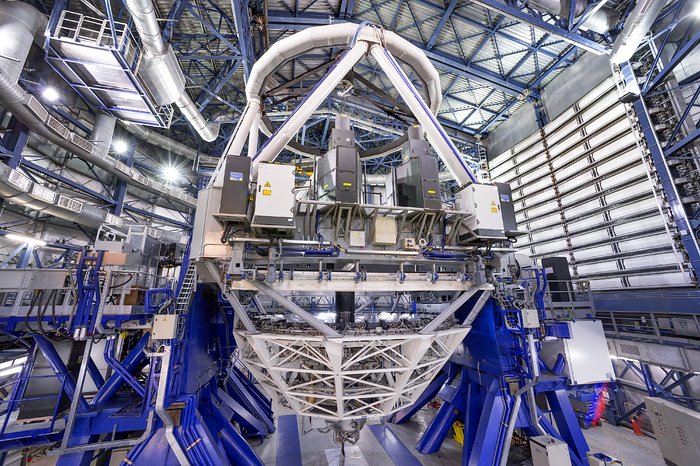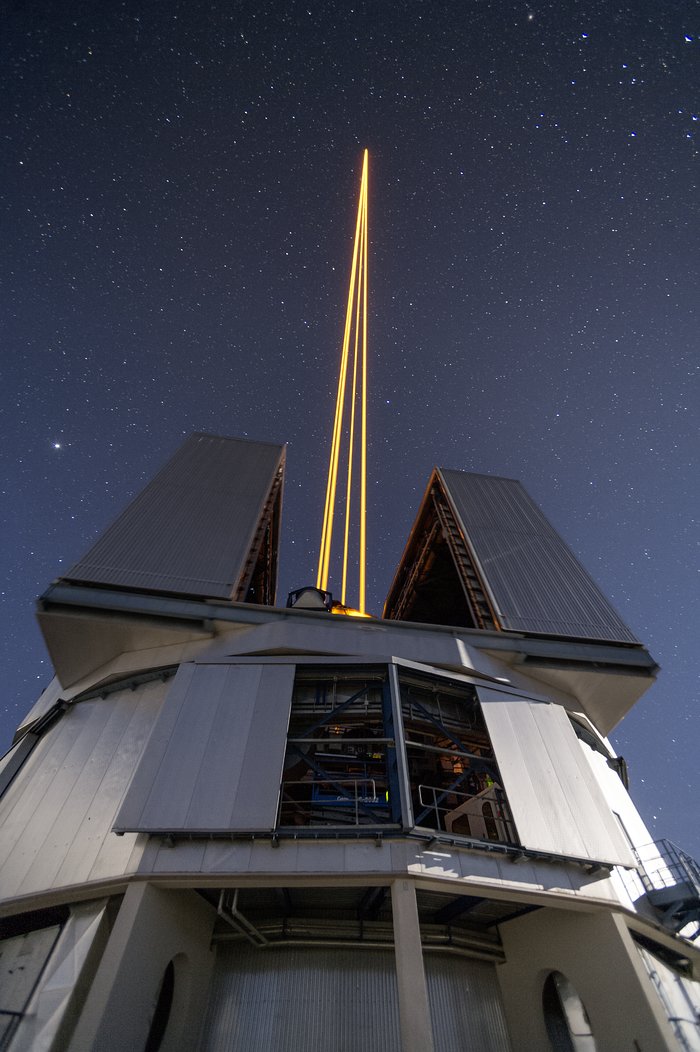Very Large Telescope has even more features.
On April 26, 2016, in the Southern European Observatory (ESO) located in the Akatami desert (Chile), a 4LGSF system of four fiber-optic lasers was tested, greatly expanding the capabilities of the Very Large Telescope. These most powerful lasers, used ever in astronomy, will become the most important component of the adaptive complex of the optical system, allowing you to track the position of celestial objects with an even higher degree of accuracy.

One of the unique opportunities opened up by the use of lasers is the creation of “artificial stars” (guide stars) that occur in the upper layers of the Earth’s atmosphere as a result of their illumination with laser beams of 22 W each.

')
The use of the Four Lasers instead of one by the Four Laser Guide Star Facility (4LGSF) makes it possible to register the distribution of turbulent air flows in the atmosphere in much more detail and compensate for the negative optical effects that affect the image quality.

The 4LGSF unit is the central part of the Adaptive Optics Facility installation on the fourth unit — the main VLT telescope (Unit Telescope 4), which creates four artificial stars for the GALACSI / MUSE and GRAAL / HAWK-I adaptive optics systems.

The ceremony was attended by leading ESO experts, including the official representative of ESO in Chile, Fernando Comeron (Fernando Comeron), as well as representatives of the companies participating in the project who manufactured the key components of the new adaptive optical system.

The 4LGSF system is manufactured by ESO specialists in cooperation with the largest European research and production companies and experimental design associations. Among them:
The general contractor is TOPTICA (Germany), responsible for the supply of the generator, frequency doubler, as well as for the development of the system management software. TOPTICA President Wilhelm Kaenders said: “TOPTICA is extremely pleased with the cooperation with ESO. And here it’s not just my old personal commitment to astronomy, not only the pleasure of working with highly professional technicians from ESO, it’s also the inspiration that we get by developing our own commercial product at such a high level. ”
It should be noted that participation in this project allowed TOPTICA to extend its product range to a new wavelength range and output power mode. Now the company produces the SodiumStar 20/2 laser, adopted as a quasi-standard for existing and planned telescopes around the world. In particular, SodiumStar is used in all projects of the next-generation super-giant telescopes. In the seven years of cooperation with ESO, the number of company employees has grown from 80 to over 200 people.
MPBC Corporation (Canada), which provided Raman’s laser pumps and amplifiers, designed in collaboration with ESO specialists. The collaboration of MPBC and ESO also led to additional useful results: the creation of a line of single-frequency amplifiers for almost any wavelengths applicable for scientific and commercial purposes. President of MPB Communications Inc. Jane Bachynski noted that: “The collaboration of MPBC and ESO has enabled us to master the development of Raman fiber amplifiers of much greater power.”
The Dutch company TNO produced a set of optics that correct the shape of the rays. TNO experts from Vernooy, Vacutech, Rovasta, Schott Benelux, Maxon Motor Benelux, IPS technology, Sensordata, WestEnd and major international companies, including RMI, Qioptiq, Laser Components, Carl Zeiss, GLP, Faes, Farnell, Eriks and Pfeiffer.
The knowledge gained by the participants of the development in the process of cooperation with ESO went far beyond the needs of the 4LGSF project and will be able to find application not only in astronomy, but also in communications, semiconductor manufacturing, medical technology, space research and Earth physics.
Several less powerful laser systems have already been installed by ESO by order of the Keck Observatory (Hawaii, USA) and the Mauna Kea Observatory (Hawaii, USA). In the future, such industrial lasers are expected to become part of a research complex at the Gemini Observatory (Hilo, Hawaii; La Serena, Chile) operated by an international association of universities for research in astronomy, and several other major observatories in the world.
Quick reference
The European Southern Observatory (the European Southern Observatory) is the most advanced international astronomical observatory in the world. 16 countries participate in the work of ESO: Austria, Belgium, Brazil, Great Britain, Germany, Denmark, Spain, Italy, the Netherlands, Poland, Portugal, Finland, France, the Czech Republic, Switzerland and Sweden, as well as Chile, which provided its territory for the placement of observatories Eso.
ESO implements a large-scale program for the design, construction, and operation of powerful ground-based observation complexes that enable astronomers to carry out essential scientific research. At the disposal of the scientific community in Chile today there are three unique observation points of world class: La Silla, Paranal and Chahnantor.
ESO is the European partner of the largest astronomical project of our time - the system of radio telescopes of the millimeter and submillimeter range ALMA. At Cerro Armazones, not far from Paranal, ESO is building a European Extremely Large Telescope E-ELT (European Extremely Large Optical / Near-infrared Telescope), a 39-meter "European Extremely Large Telescope" for the optical and near-infrared ranges, aspiring to the sky. "
That's all, with you there was a simple service for choosing sophisticated Dronk.Ru equipment. Do not forget to subscribe to our blog , there will be many more interesting things.

LetyShops cashback service sponsor . Return money for any purchases on the Internet. Read more about what a cashback service is in our article. We choose a cashback service for the 6th anniversary of Aliexpress.

One of the unique opportunities opened up by the use of lasers is the creation of “artificial stars” (guide stars) that occur in the upper layers of the Earth’s atmosphere as a result of their illumination with laser beams of 22 W each.

')
The use of the Four Lasers instead of one by the Four Laser Guide Star Facility (4LGSF) makes it possible to register the distribution of turbulent air flows in the atmosphere in much more detail and compensate for the negative optical effects that affect the image quality.

The 4LGSF unit is the central part of the Adaptive Optics Facility installation on the fourth unit — the main VLT telescope (Unit Telescope 4), which creates four artificial stars for the GALACSI / MUSE and GRAAL / HAWK-I adaptive optics systems.

The ceremony was attended by leading ESO experts, including the official representative of ESO in Chile, Fernando Comeron (Fernando Comeron), as well as representatives of the companies participating in the project who manufactured the key components of the new adaptive optical system.

The 4LGSF system is manufactured by ESO specialists in cooperation with the largest European research and production companies and experimental design associations. Among them:
The general contractor is TOPTICA (Germany), responsible for the supply of the generator, frequency doubler, as well as for the development of the system management software. TOPTICA President Wilhelm Kaenders said: “TOPTICA is extremely pleased with the cooperation with ESO. And here it’s not just my old personal commitment to astronomy, not only the pleasure of working with highly professional technicians from ESO, it’s also the inspiration that we get by developing our own commercial product at such a high level. ”
It should be noted that participation in this project allowed TOPTICA to extend its product range to a new wavelength range and output power mode. Now the company produces the SodiumStar 20/2 laser, adopted as a quasi-standard for existing and planned telescopes around the world. In particular, SodiumStar is used in all projects of the next-generation super-giant telescopes. In the seven years of cooperation with ESO, the number of company employees has grown from 80 to over 200 people.
MPBC Corporation (Canada), which provided Raman’s laser pumps and amplifiers, designed in collaboration with ESO specialists. The collaboration of MPBC and ESO also led to additional useful results: the creation of a line of single-frequency amplifiers for almost any wavelengths applicable for scientific and commercial purposes. President of MPB Communications Inc. Jane Bachynski noted that: “The collaboration of MPBC and ESO has enabled us to master the development of Raman fiber amplifiers of much greater power.”
The Dutch company TNO produced a set of optics that correct the shape of the rays. TNO experts from Vernooy, Vacutech, Rovasta, Schott Benelux, Maxon Motor Benelux, IPS technology, Sensordata, WestEnd and major international companies, including RMI, Qioptiq, Laser Components, Carl Zeiss, GLP, Faes, Farnell, Eriks and Pfeiffer.
The knowledge gained by the participants of the development in the process of cooperation with ESO went far beyond the needs of the 4LGSF project and will be able to find application not only in astronomy, but also in communications, semiconductor manufacturing, medical technology, space research and Earth physics.
Several less powerful laser systems have already been installed by ESO by order of the Keck Observatory (Hawaii, USA) and the Mauna Kea Observatory (Hawaii, USA). In the future, such industrial lasers are expected to become part of a research complex at the Gemini Observatory (Hilo, Hawaii; La Serena, Chile) operated by an international association of universities for research in astronomy, and several other major observatories in the world.
Quick reference
The European Southern Observatory (the European Southern Observatory) is the most advanced international astronomical observatory in the world. 16 countries participate in the work of ESO: Austria, Belgium, Brazil, Great Britain, Germany, Denmark, Spain, Italy, the Netherlands, Poland, Portugal, Finland, France, the Czech Republic, Switzerland and Sweden, as well as Chile, which provided its territory for the placement of observatories Eso.
ESO implements a large-scale program for the design, construction, and operation of powerful ground-based observation complexes that enable astronomers to carry out essential scientific research. At the disposal of the scientific community in Chile today there are three unique observation points of world class: La Silla, Paranal and Chahnantor.
ESO is the European partner of the largest astronomical project of our time - the system of radio telescopes of the millimeter and submillimeter range ALMA. At Cerro Armazones, not far from Paranal, ESO is building a European Extremely Large Telescope E-ELT (European Extremely Large Optical / Near-infrared Telescope), a 39-meter "European Extremely Large Telescope" for the optical and near-infrared ranges, aspiring to the sky. "
That's all, with you there was a simple service for choosing sophisticated Dronk.Ru equipment. Do not forget to subscribe to our blog , there will be many more interesting things.

LetyShops cashback service sponsor . Return money for any purchases on the Internet. Read more about what a cashback service is in our article. We choose a cashback service for the 6th anniversary of Aliexpress.
Source: https://habr.com/ru/post/393525/
All Articles